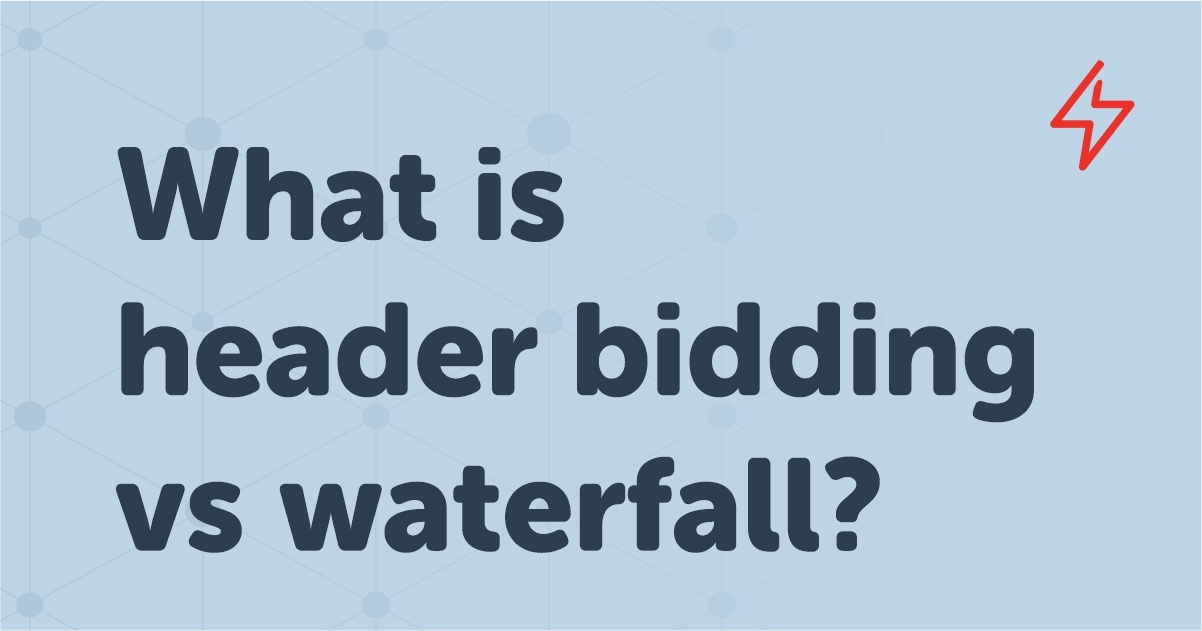Table of Contents
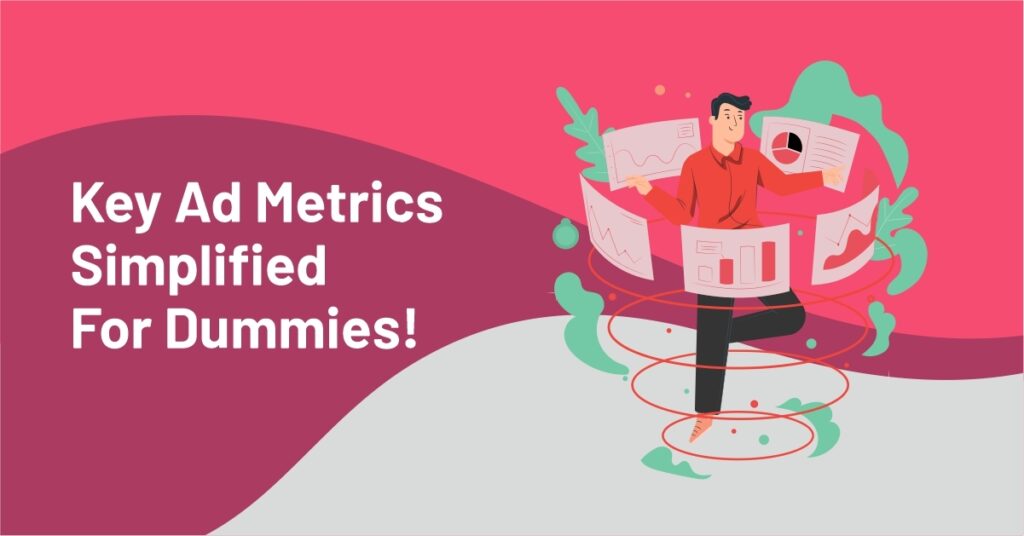
The world of AdTech is full of jargon-like terms. It adds more metrics to calculate ad revenue and improve understanding of publisher earnings based on factors affecting profits such as sessions, page views, users, and more. If you are a publisher, you must have heard of CPM, eCPM, RPM, and EPMV. It’s vital to comprehend the critical variances between these terms so you can correctly calculate revenue.
We will take each of these single metrics under the microscope to answer any questions you might have. Let’s dive deep into what each term means and understand how these metrics matter to you. We will also discuss EPMV, a metric that can help publishers get a holistic view of their earnings, and why it is the best metric for Revenue and Yield. You will be better equipped to use EPMV to gauge your monetization strategy by the end of this blog.
Let’s take every single metric under scrutiny for better understanding:
- What is CPM?
- What is a good CPM?
- Benefits of CPM
- What is eCPM?
- Benefits of eCPM
- CPM vs eCPM
- What is RPM?
- RPM vs CPM
- What is EPMV?
- The benefit of EPMV
- Comparison between CPM, eCPM, RPM, and EPMV
- What is the best metric for Revenue and Yield?
- Why is EPMV gradually gaining popularity amongst Publishers?
What is CPM?
CPM is one of the significant advertising metrics. CPM refers to the cost per mille, i.e., the cost per thousand impressions. Simply it means the cost of having an ad published, seen a thousand times on a particular website, and is used to inspect and oversee ad performance. Since early online marketing campaigns, CPM has acted as an industry standard that determines the advertising costs and pricing web ads. CPM calculation is simple, take the total cost paid in CPM campaigns and then multiply by the Total Impressions by the CPM rate & then divide it by one thousand. For example, one million impressions at 1 $ CPM equals $1000 in gross revenue.
How to calculate CPM?
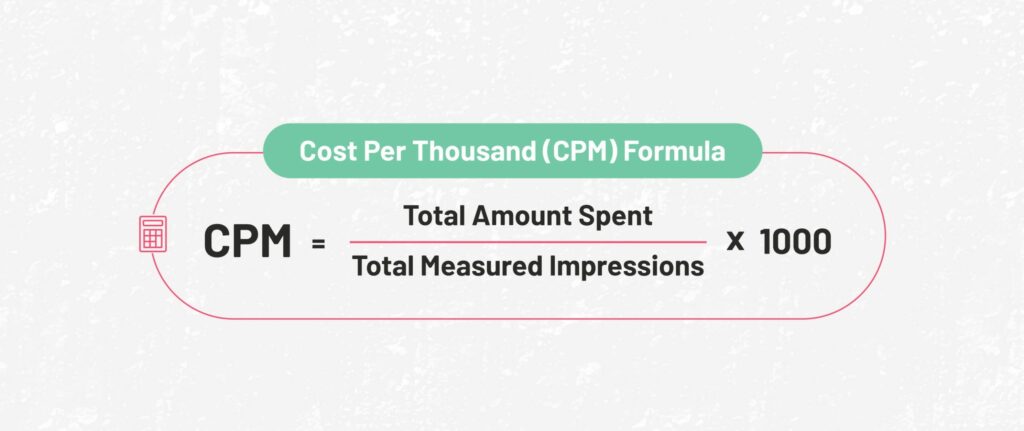
What is a good CPM?
What is a good CPM? Why aren’t low-cost CPMs the best? We detest the concept of What is a good CPM? Or What is a bad CPM? As there really isn’t one solid answer to this question. What is a good CPM? It really depends predominantly on two significant factors:
- What strategies and tactics are you using?
- Your actual campaign goals
As with most monetization metrics and pricing models, you cannot conclude if a CPM is good or bad based only on a particular or single value. Scrutinizing past performance data, benchmarking outcomes against averages for your market, and assessing the impact of CPMs on your ROI can help you establish whether your CPM impressions are a good pricing model for your advertising undertakings. A lesser or lower CPM is not always a constructive indicator for an advertiser, as it may be a sign of poor-quality traffic. Similarly, for publishers, having a high CPM doesn’t automatically decode higher earnings, as some ad inventory may not be sold yet.
Benefits of CPM:
CPM endures being a vital metric for publishers! Nonetheless, analysts and strategists now have an abundance of data and metrics to measure user engagement and ad effectiveness, but CPM remains the flag bearer. Now, let’s talk more about benefits of CPM:
Here are the benefits of CPM for publishers:
Highly Profitable: CPM is profitable for publishers, as publishers receive revenue just for placing ads on their website. It is easier than getting users to click on or engage with an ad, but usually, these results depend more on advertising itself than a publisher.
No added efforts: Simpler to monetize inventory with cost per thousand impressions model. CPM cost per mille is easy; however, the publisher’s ad inventory must reach a specific bar of daily user views to serve ads on the CPM ad platform. Every platform has distinctive requirements concerning an absolute number of visits.
No keyword gathering: With CPM cost per mille ads, publishers don’t need to consider keyword selection for their website targeting. Programmatic advertising is created to personalize each impression for every viewer, so keywords are not required.
Easily countable performance: To calculate how much profit publishers can get by placing cost per thousand impressions ads, they can use distinctive estimations – an average number of served impressions, daily-active-users count. Plus, these metrics can be merged with specific ad network metrics, such as eCPM.
What is eCPM?
Let’s find out the answer to the question, what is eCPM? eCPM is a crucial ad performance metric used by publishers to inspect and monitor the revenue generated from the ads on their site. As we witness, eCPM often gets confused with the CPM metric by the publishers. It’s easy to get confused with these two terms at first, but once you complete reading this article, that won’t happen again. We’ll see the difference between CPM vs. eCPM and how you can calculate eCPM.
What is eCPM? eCPM is an abbreviation that means effective cost per mille. Remember, “Mille” is a Latin word for thousand. eCPM metric is dividing the ad revenue per campaign or banner by the number of thousand ad impressions. eCPM is also a way to measure the performance of an ad based on the revenue produced for every thousand impressions.
You need to pay special consideration to the term ‘effective.’ Here, effective CPM means the revenue earned by the publishers, effectively and efficiently. eCPM is cumulative revenue spawned by publishers per thousand impressions. Hence, eCPM is not merely calculated using CPM campaigns but also CPC, CPL, and other such campaigns running via the publisher’s inventory.
How to calculate eCPM?
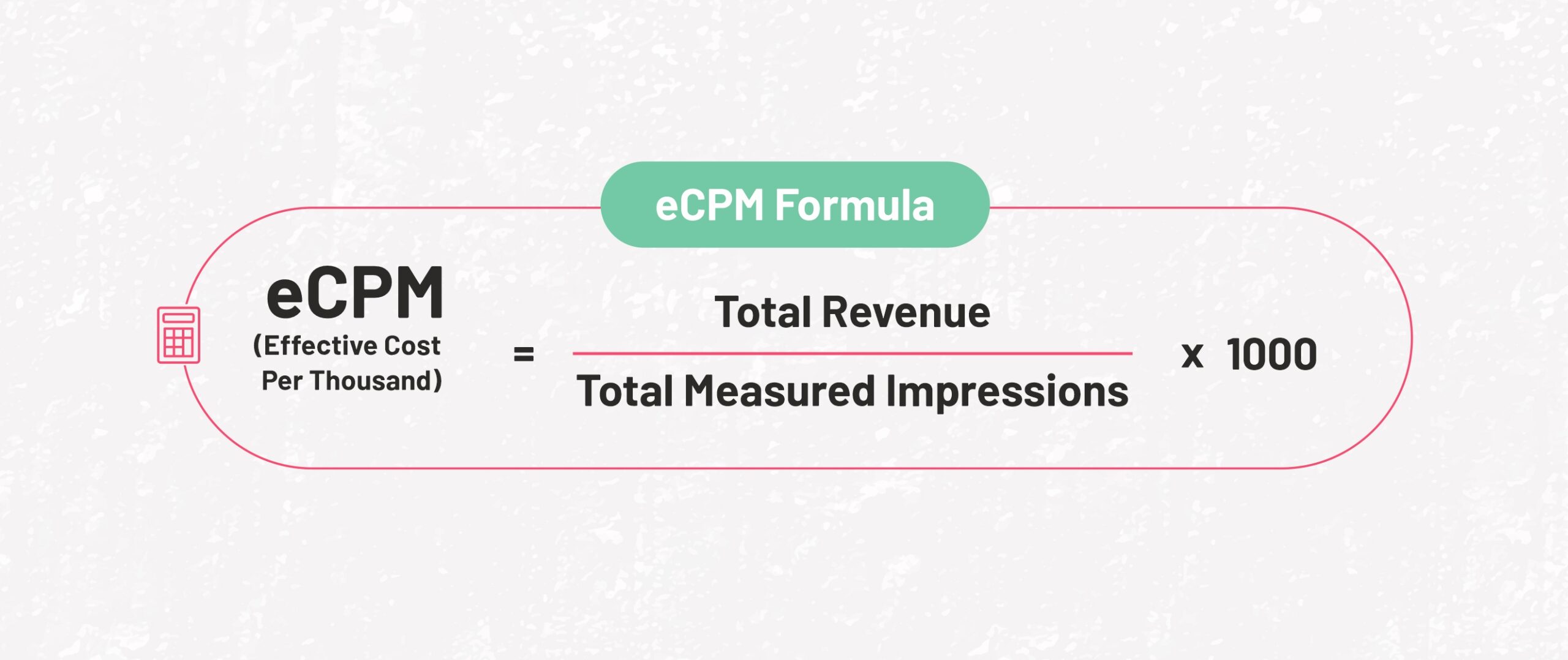
Benefits of eCPM:
- eCPM is a strategic metric as it helps publishers to assess their future revenue. Using the average eCPM from past campaigns, an individual can create targets and use them as criteria for testing the best-performing ads on the site
- eCPM helps publishers evaluate their monetization efforts’ performance irrespective of channel, ad type, and pricing model. With eCPM, publishers can compare the adequate revenue from various ad units even if their pricing model differs
- eCPM helps predict the remunerations and earnings of the publishers. A target earning number can work as a significant motivational factor for publishers to operate appropriately. If an individual is performing ad testing to find the best performing ads for a website, then eCPM attained for multiple ad tests can help him choose the front-runner
What is the key difference between CPM and eCPM?
Let’s talk about CPM vs eCPM here today! Firstly, CPM vs eCPM points out that CPM is a reach and pricing metric used mainly by advertisers to evaluate the cost of their campaigns and the reach generated by their allocated budget.
However, for publishers, using CPM to assess revenue can be ambiguous. Multiple exceptions create alterations between the price set by the publisher on a thousand impressions and the authentic revenue generated. For example, a sizable advertiser may have more impressions than what they actually paid for. Other advertisers may have spent more, as the number of impressions came up to thousand.
The war between CPM vs eCPM on the publishers’ ground, hands down, eCPM is a publisher’s metric! eCPM resolves those issues by calculating the effective revenue for every thousand impressions. However, eCPMs can be calculated not just for CPM campaigns but for CPC and CPL too. It allows publishers to associate the effectiveness of various types of advertising and optimize to surge revenue accordingly.
The foremost difference between CPM and eCPM is that CPM is only used to calculate cost per a thousand impressions in a CPM ad buying model. In contrast, CPM vs eCPM tug-of-war, eCPM is a revenue metric that can be applied to any pricing method irrespectively.
What is RPM?
We will put another valuable metric that publishers can utilize to understand better their performance under scrutinization – RPM. The RPM refers to the revenue per thousand impressions and comprises added subcategories. There are two types of RPM available for the publishers:
- Page RPM, i.e., page revenue per thousand impressions
- Session RPM, i.e., session revenue per thousand impressions
Let’s dive in and understand the purpose of each type of RPM and how it helps publishers to monitor and grow the overall website earnings. RPM is a standard metric that most advertising platforms such as ad networks and ad servers use. RPM represents the publisher’s revenue for every 1,000 page views on a publisher’s website. For calculating RPM, an individual needs to divide the Revenue by Total Page Views and multiply it by 1,000 using the formula below.
How to calculate RPM?
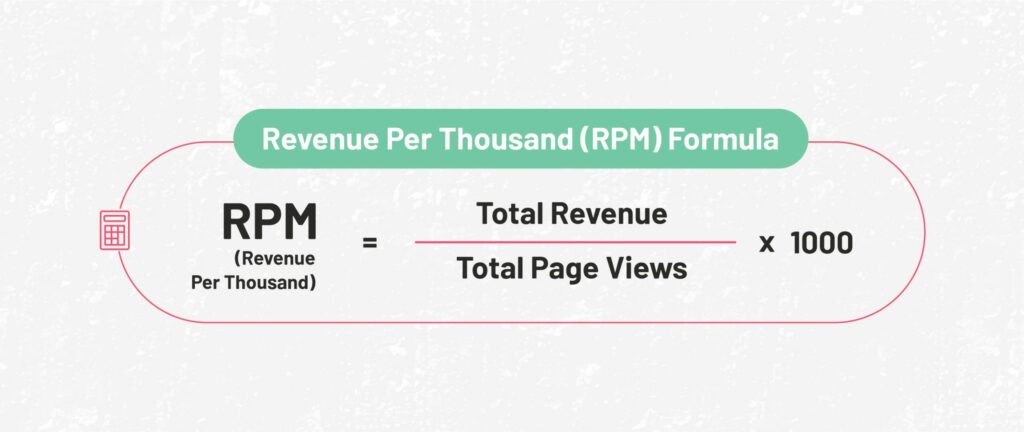
What is page RPM?
The page RPM metric helps publishers comprehend the performance of their ads on a page level. This way, a publisher can recognize low-earning pages and strategize how to progress and advance their performance. Page RPM = Revenue / Number of page views x 1,000. Page RPM is an outstanding proportional metric to assess multiple page performance on the website. It gives publishers a real picture of what’s going on with the pages concerning revenue at any equivalent period, page to page, and more.
What is session RPM?
Session RPM is a crucial metric while analyzing overall site performance. Session RPM openly shows a site’s ad earnings per visitor. Session RPM gives publishers a better understanding of which landing pages gain revenue the most. Session RPM= Revenue/Number of user sessions x 1,000.
RPM vs CPM
When comparing RPM vs CPM, there are a few clear distinctions to make. RPM is a metric used to define the total ad revenue a publisher is set to earn for 1000 ad impressions. Whereas CPM is the amount, an advertiser will pay for 1000 ad impressions. Nevertheless, the two are used interchangeably throughout the digital media industry. Let’s analyze and dig deep on RPM vs CPM:
| Comparison | CPM | RPM |
|---|---|---|
| Definition | Cost Per Mile | Revenue Per Mile |
| Meaning | Determines how much the advertiser will be charged on showing a thousand impressions for ad | Determines how much a publisher will earn on showing thousand ad impressions on a web property |
| Calculation | Divide the total cost incurred by the advertiser with various impressions and then dividing that by a thousand | It is calculated by estimated earnings divided by the number of page views, multiplied by a thousand |
| Usage | Test which ad campaign is performing better for the advertiser | Indicates the publisher being paid a good amount as compared to another ad network/broker |
| Optimization | When the advertiser runs a CPM campaign, AI is used to decide what is the best target audience for the campaign | The publisher can try to optimize his RPM by creating multiple ad placements and testing multiple types of ads like text, link, image, and video ads |
| Cost | The advertiser is billed per thousand impressions | The ad network/broker takes a commission cut and transfers the remaining amount to the publisher |
What is EPMV?
EPMV refers to Earnings per Thousand Visitors or session revenue, or session RPM. EPMV is used to analyze the overall revenue produced or created on an individual’s site for thousand visitors comprising earnings from numerous ad networks, exchanges, and SSPs. Additionally, EPMV is computed for the entire site. Henceforth, EPMV offers a birds-eye view or scrutinized analysis of the publisher’s earnings.
How to calculate EPMV?
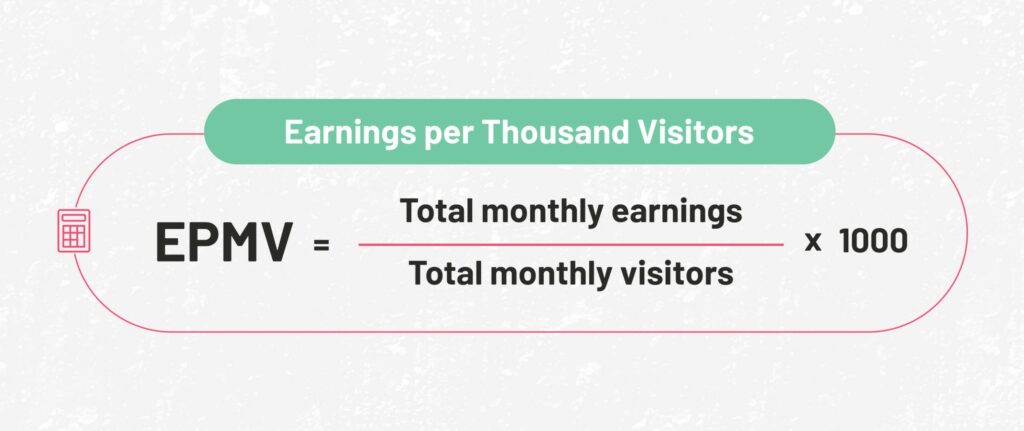
The benefit of EPMV:
The main aim of EPMV is to empower publishers to measure revenue for their sites. Other metrics like Page RPM focus only on a page per page basis. EPMV is a practical measuring component for publishers to get a holistic view of how their inventory is performing. EPMV gives the publisher an idea of whether their efforts to drive traffic to the sites are advancing them or not.
Let’s say an individual is testing ad layouts on the site, and for a particular page, he decides to add a few additional ad units. As an outcome, the ad revenue might intensify for that specific page. However, as users find it hard to ingest the content because of an ad overload, some bounce faster than before. Instead of visiting multiple pages and amplifying their chances of clicking on the ads, users only visit one page and leave due to a wrong or lousy experience.
EPMV gives you an aerial perspective. This way, an individual can decide whether the modifications to the layout from one page are harming the ad earnings overall. Remember, this is a mere example to illustrate a point, and that with any ad optimization, testing is required. Be mindful that EPMV and Session RPM are similar, and that Session RPM is more frequently used among publishers. Be sure to read more about the distinctive types of RPM, like page RPM, session RPM, and eCPM, as these metrics are often used in the monetization world.
Comparison between CPM, eCPM, RPM, and EPMV
Let’s check out the fundamental differences CPM, eCPM, RPM, and EPMV share with actual formulas and calculations. With AdSparc, decode with a live example and what exactly do CPM, eCPM, RPM, and eCPM measure and how you can utilize them to your ad optimization advantage:
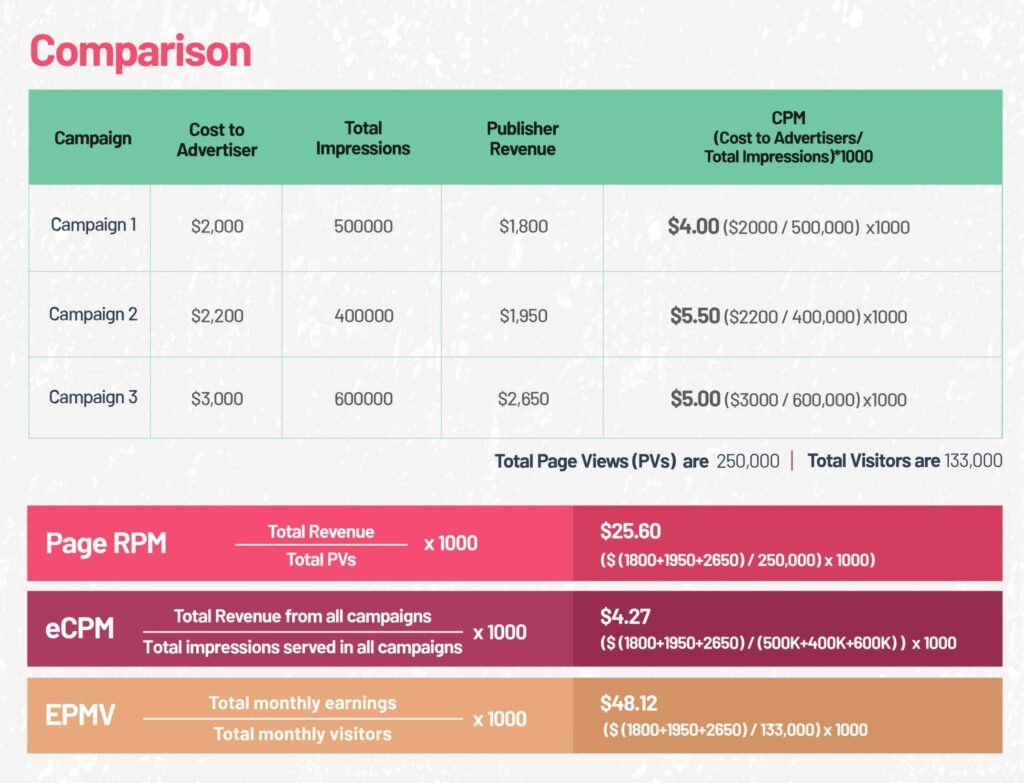
What is the best metric for Revenue and Yield?
EPMV is the clear winner.
EPMV is the most consolidated metric for Publishers to understand their overall revenue and growth. EPMV includes two absolute values, i.e., income and visitors, and provides an accurate function for the publisher’s efforts. EPMV is the best metric for revenue and yield because EPMV considers the bounce rate and page views per visit automatically. EPMV is the only way to measure if the revenue is going in the right direction despite outside factors like seasonality.
Why is EPMV gradually gaining popularity amongst Publishers?
The main reason for this is that most publishers work with numerous ad networks and ad exchanges, only offering to report their own performance. That means it generally involves added effort to calculate the EPMV. However, EPMV is one of the most valuable and useful metrics for publishers to comprehend their overall revenue and growth. As you have witnessed in the blog that EPMV comprises two absolute values, i.e., revenue and visitors, and offers an accurate function for the publisher’s efforts. Some ad tech vendors have started showing their revenue in session RPM or EPMV. Even if your ad partner doesn’t deliver unified reporting or you are handling your own ad stack, it is easy to calculate the EMPV on your own with our complete and exclusive guide on ad metrics! Try out EPMV with AdSparc’s detailed comparison analysis, and we assure you that it will be worth the effort. Happy Monetizing to You!
Also Read: App Monetization – The Must-Have Innovative Ad Formats to Maximize In-App Revenue
